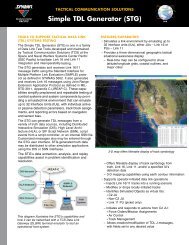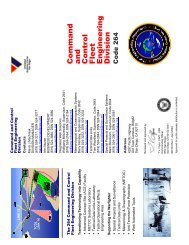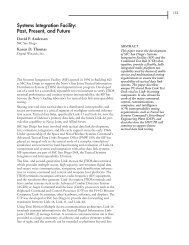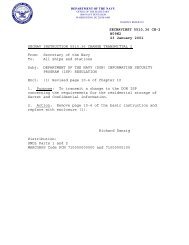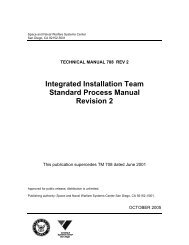Intelligence, Surveillance, and Reconnaissance - Spawar
Intelligence, Surveillance, and Reconnaissance - Spawar
Intelligence, Surveillance, and Reconnaissance - Spawar
Create successful ePaper yourself
Turn your PDF publications into a flip-book with our unique Google optimized e-Paper software.
184<br />
INTELLIGENCE, SURVEILLANCE, AND RECONNAISSANCE<br />
split-aperture adaptive beamforming process. The objective is to generate<br />
signal clusters in bearing <strong>and</strong> frequency space. Tracking is accomplished<br />
by association of clusters, in bearing <strong>and</strong> frequency space (narrowb<strong>and</strong>)<br />
or bearing only (broadb<strong>and</strong>), over time (Figure 4). An – tracker is used<br />
to associate the acoustic clusters to the magnetic track to form a contact<br />
track [5].<br />
Contact Classification<br />
Contact tracks, generated by the acoustic <strong>and</strong> magnetic track association<br />
process, include contact data structures that are the input to the classification<br />
process. These data structures consist of the magnetic <strong>and</strong> acoustic<br />
feature sets listed below.<br />
1. Magnetic (MA): defines specific magnetic features such as magnetic<br />
moment, depth, <strong>and</strong> magnetic score. Membership functions are used<br />
to provide the scoring criteria.<br />
2. Number of Blade Harmonics (NBH): defines a blade harmonic<br />
structure <strong>and</strong> provides membership functions for evaluating the<br />
number of blade harmonics.<br />
3. Blade Harmonic Power (BHP): provides a membership function<br />
for evaluating the range normalized average power in each blade<br />
harmonic.<br />
4. Non-Blade Power (NBP): provides a membership function for<br />
evaluating the range normalized average power in each non-blade<br />
narrow-b<strong>and</strong> signal.<br />
5. Contact Bearing Rate (CBR): provides a membership function for<br />
evaluating the contact bearing rate.<br />
6. Number of Signal Events (NSE): provides a membership function<br />
for evaluating the number of associated signal events in each contact<br />
track.<br />
A discriminant score for each contact is calculated using these features<br />
<strong>and</strong> associated membership functions [6]. The membership functions provide<br />
estimates of the probability of existence of each of the features. The<br />
contact discriminant scoring function is shown below in Eq. (2)<br />
DS = DSMA + DSNBH + DSBHP + DSNBP + DSCBR + DSNSE (2)<br />
where DS is the discriminant score (ranges from –1 to +1), DSMA is the<br />
magnetic discriminant score, DSNBH is the number of blade harmonics<br />
discriminant score, DSBHP is the blade harmonics power discriminant<br />
score, DSNBP is the non-blade harmonics power discriminant score,<br />
DSCBR is the contact bearing rate discriminant score, <strong>and</strong> DSNSE is the<br />
number of signal events discriminant score.<br />
Contact Scoring<br />
The decision to transmit a contact report to the comm<strong>and</strong> center is based<br />
on the contact score. The contact score is calculated <strong>and</strong> updated from<br />
one processing interval to the next by using a discriminant function classifier.<br />
The algorithm used by the classifier is given below in Eq. (3).<br />
TS(i) = TS(i–1) + K[DS(i) –TS(i–1)] (3)<br />
where TS is the target score (ranges from –1 to +1), K is the smoothing<br />
constant (ranges from 0.2 to 0.8), <strong>and</strong> DS is the discriminant score (ranges<br />
from –1 to +1). The target score is computed with a first-order recursion.<br />
TIME<br />
BEARING<br />
FIGURE 4. Association of acoustic (blue)<br />
<strong>and</strong> magnetic track (red) in time <strong>and</strong><br />
bearing.



